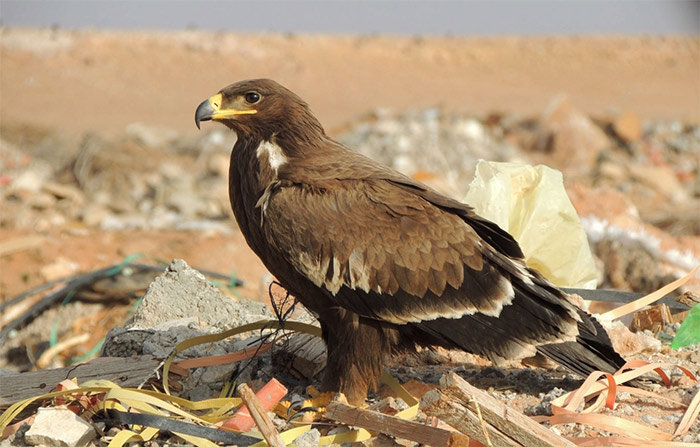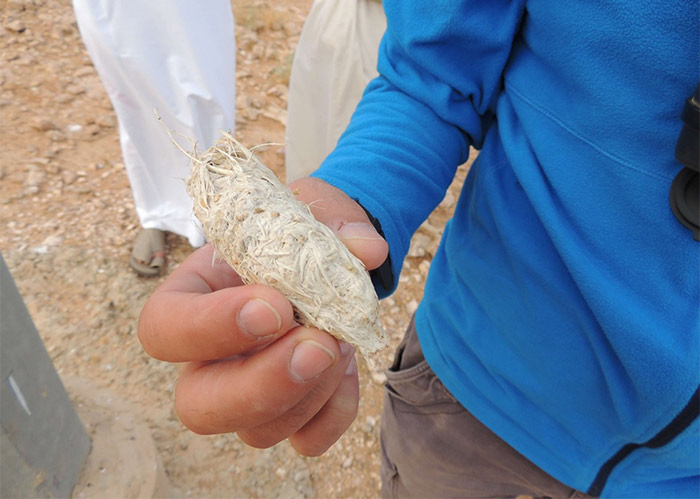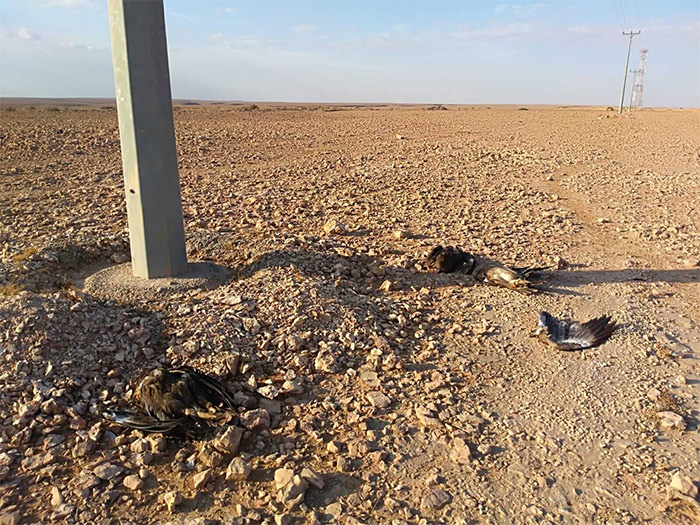6,000 Endangered Steppe Eagles find refuge within refuse dumps
If you wanted to see 6,000 Endangered eagles, a rubbish dump might not be the first place you’d think of looking. But conservationists in Saudi Arabia are working to make these unlikely havens safe for the birds that call them home.

Nowadays, it is increasingly rare and mesmerising to catch a glimpse of the majestic Steppe Eagle. This large, powerful bird of prey was once considered the most common large eagle in the world, but has been tragically declining since 1997 – largely due to habitat loss – and since 2015 the species has been listed as Endangered. However, earlier this year, a few lucky conservationists got a sighting they didn’t expect when they found around 6,700 Steppe Eagles at two rubbish dumps 170 kilometres north of Riyadh, Saudi Arabia, scavenging on animal carcasses & remains of chickens from animal farms.
The adventure started when a team researching Steppe eagles wintering in Oman noticed that a large proportion of the satellite-tagged Steppe Eagles they were tracking were showing up near the town of Shaqra in central Saudi Arabia. Curious, the team reached out to birders in Saudi Arabia asking for their help. Mischa Keijmel, Technical Manager at an engineering firm, happily obliged.
When the new recruit embarked on this journey, he had no idea of the bonanza he was about to stumble upon. He visited two rubbish dumps located 12 kilometres apart; one is about nine kilometres from the town of Shaqra, and another six and a half kilometres southwest of the town of Ushaiqer. Upon his arrival at the first dump, he noticed many eagles standing on pylons – posing a direct risk of electrocution. Keijmel described the surroundings as “slightly undulating, barren plains covered with small rocks and devoid of vegetation” – an unlikely wildlife haven. “In this landscape, observations of large birds such as eagles can be made over several kilometres” says Keijmel, describing how he was able to get an accurate estimate of the number of eagles.
After a number of subsequent visits and repeat counts at the sites, Mischa and his cooperators confirmed up to 6,000 Steppe Eagles at Ushaiqer alone, 60-70% of which were adults. A further 1,200 were found at Shaqra. This is the largest gathering of this globally threatened species ever recorded anywhere in the world, and accounts for approximately 4.5-9% of the estimated global population.

The research in Oman that resulted in this find is a collaboration mainly between the Office for Conservation of Environment (Oman), AridLands (Oman), and International Avian Research (Austria), with funding from the Anglo-Omani Society (UK) and the Bernd Meyburg Foundation for Raptor Research and Conservation (Germany).
As luck would have it, at the same time an international team from the Egyptian Vulture New LIFE project, including the Saudi Wildlife Authority (SWA), BirdLife’s Middle East office, BSPB (BirdLife in Bulgaria), and RSCN (BirdLife in Jordan), was in the region to survey threats to the Egyptian Vulture (Endangered) and other birds of prey. Hearing about this latest discovery, they added the Steppe Eagle to their priority list.
Their research highlighted electrocution and collision with power lines as serious threats. Fifteen dead Steppe Eagles were found along just two kilometres of power line at the entrance of the dump in Ushaiqer, and several dozen more were found along four kilometres of power line near a third dump at Al Qunfudhah city. Under some of the killer poles, the remains of seven or eight individuals were found. Black Kite, Booted Eagles, Corncrakes and other bird species were also found among the victims.

Furthermore, based on interviews with local people, the research team found that poisoned bait is commonly used to control predators such as feral dogs, wolves and hyenas. As if this wasn’t dangerous enough, drugs like diclofenac – a painkiller for livestock, but toxic to vultures and eagles – were widespread in almost every veterinary pharmacy visited by researchers. Since local people traditionally dispose of deceased livestock out in nature, this poses a serious threat to scavengers.
“Although we were surprised to find such a large number of eagles at this previously unknown site, it highlights the possibility of a commensurately large tragedy occurring due to electrocution and poisoning events; such events have been seen in other locations”, says Mike McGrady of International Avian Research.
However, despite these serious threats, there are also great opportunities for conservation and birdwatching – especially since such a huge concentration of eagles has the potential to generate popular interest in these areas. In November 2019, just after the expedition, the results were presented at an international workshop about Birds and Energy hosted by SWA in Riyadh. All attendees expressed their concern and agreed on the need for urgent actions to prevent further electrocution incidents, especially at major congregation sites.
“These findings highlight the utility of satellite tracking in discovering important sites for birds, and the benefits of international collaboration to identify and mitigate threats to migratory birds”, says Professor Mohammed Shobrak from SWA.
Birdlife International
19 May 2020
Share this story




